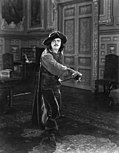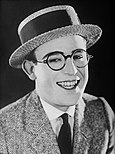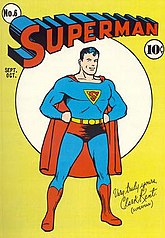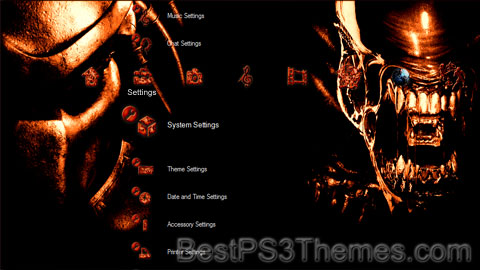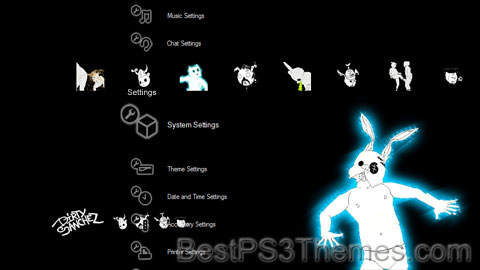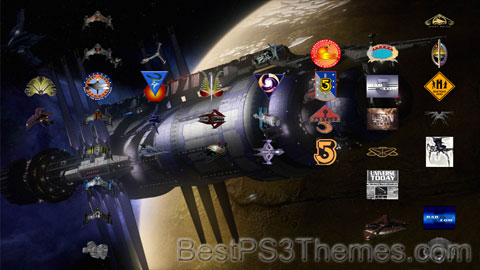Superman theme by Big Nes
Download: Superman_2.p3t
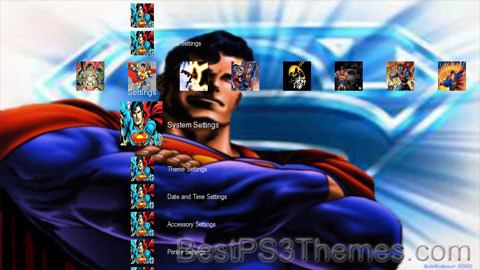
(11 backgrounds)
| Clark Kent / Kal-El Superman | |
|---|---|
 | |
| Publication information | |
| Publisher | DC Comics |
| First appearance | Action Comics #1 (cover-dated June 1938; published April 18, 1938) |
| Created by | Jerry Siegel (writer) Joe Shuster (artist) |
| In-story information | |
| Alter ego | Kal-El (birth name) Clark J. Kent (adopted name) |
| Species | Kryptonian |
| Place of origin | Krypton |
| Team affiliations | |
| Partnerships |
|
| Notable aliases |
|
| Abilities |
|
Superman is a superhero who appears in American comic books published by DC Comics. The character was created by writer Jerry Siegel and artist Joe Shuster, and debuted in the comic book Action Comics #1 (cover-dated June 1938 and published April 18, 1938).[1] Superman has been adapted to a number of other media, which includes radio serials, novels, films, television shows, theater, and video games.
Superman was born on the fictional planet Krypton with the birth name of Kal-El. As a baby, his parents sent him to Earth in a small spaceship shortly before Krypton was destroyed in a natural cataclysm. His ship landed in the American countryside near the fictional town of Smallville, Kansas. He was found and adopted by farmers Jonathan and Martha Kent, who named him Clark Kent. Clark began developing various superhuman abilities, such as incredible strength and impervious skin. His adoptive parents advised him to use his powers for the benefit of humanity, and he decided to fight crime as a vigilante. To protect his personal life, he changes into a colorful costume and uses the alias "Superman" when fighting crime. Clark resides in the fictional American city of Metropolis, where he works as a journalist for the Daily Planet. Superman's supporting characters include his love interest and fellow journalist Lois Lane, Daily Planet photographer Jimmy Olsen, and editor-in-chief Perry White, and his enemies include Brainiac, General Zod, and archenemy Lex Luthor.
Superman is the archetype of the superhero: he wears an outlandish costume, uses a codename, and fights evil with the aid of extraordinary abilities. Although there are earlier characters who arguably fit this definition, it was Superman who popularized the superhero genre and established its conventions. He was the best-selling superhero in American comic books up until the 1980s.[2]
Development[edit]
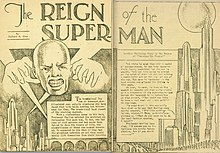
Jerry Siegel and Joe Shuster met in 1932 while attending Glenville High School in Cleveland and bonded over their admiration of fiction. Siegel aspired to become a writer and Shuster aspired to become an illustrator. Siegel wrote amateur science fiction stories, which he self-published as a magazine called Science Fiction: The Advance Guard of Future Civilization. His friend Shuster often provided illustrations for his work.[3] In January 1933, Siegel published a short story in his magazine titled "The Reign of the Superman". The titular character is a homeless man named Bill Dunn who is tricked by an evil scientist into consuming an experimental drug. The drug gives Dunn the powers of mind-reading, mind-control, and clairvoyance. He uses these powers maliciously for profit and amusement, but then the drug wears off, leaving him a powerless vagrant again. Shuster provided illustrations, depicting Dunn as a bald man.[4]
Siegel and Shuster shifted to making comic strips, with a focus on adventure and comedy. They wanted to become syndicated newspaper strip authors, so they showed their ideas to various newspaper editors. However, the newspaper editors told them that their ideas were insufficiently sensational. If they wanted to make a successful comic strip, it had to be something more sensational than anything else on the market. This prompted Siegel to revisit Superman as a comic strip character.[5][6] Siegel modified Superman's powers to make him even more sensational: Like Bill Dunn, the second prototype of Superman is given powers against his will by an unscrupulous scientist, but instead of psychic abilities, he acquires superhuman strength and bullet-proof skin.[7][8] Additionally, this new Superman was a crime-fighting hero instead of a villain, because Siegel noted that comic strips with heroic protagonists tended to be more successful.[9] In later years, Siegel once recalled that this Superman wore a "bat-like" cape in some panels, but typically he and Shuster agreed there was no costume yet, and there is none apparent in the surviving artwork.[10][11]
Siegel and Shuster showed this second concept of Superman to Consolidated Book Publishers, based in Chicago.[12][a] In May 1933, Consolidated had published a proto-comic book titled Detective Dan: Secret Operative 48.[13] It contained all-original stories as opposed to reprints of newspaper strips, which was a novelty at the time.[14] Siegel and Shuster put together a comic book in a similar format called The Superman. A delegation from Consolidated visited Cleveland that summer on a business trip and Siegel and Shuster took the opportunity to present their work in person.[15][16] Although Consolidated expressed interest, they later pulled out of the comics business without ever offering a book deal because the sales of Detective Dan were disappointing.[17][18]
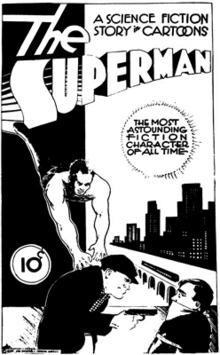
Siegel believed publishers kept rejecting them because he and Shuster were young and unknown, so he looked for an established artist to replace Shuster.[19] When Siegel told Shuster what he was doing, Shuster reacted by burning their rejected Superman comic, sparing only the cover. They continued collaborating on other projects, but for the time being Shuster was through with Superman.[20]
Siegel wrote to numerous artists.[19] The first response came in July 1933 from Leo O'Mealia, who drew the Fu Manchu strip for the Bell Syndicate.[21][22] In the script that Siegel sent to O'Mealia, Superman's origin story changes: He is a "scientist-adventurer" from the far future when humanity has naturally evolved "superpowers". Just before the Earth explodes, he escapes in a time-machine to the modern era, whereupon he immediately begins using his superpowers to fight crime.[23] O'Mealia produced a few strips and showed them to his newspaper syndicate, but they were rejected. O'Mealia did not send to Siegel any copies of his strips, and they have been lost.[24]
In June 1934, Siegel found another partner: an artist in Chicago named Russell Keaton.[25][26] Keaton drew the Buck Rogers and Skyroads comic strips. In the script that Siegel sent Keaton in June, Superman's origin story further evolved: In the distant future, when Earth is on the verge of exploding due to "giant cataclysms", the last surviving man sends his three-year-old son back in time to the year 1935. The time-machine appears on a road where it is discovered by motorists Sam and Molly Kent. They leave the boy in an orphanage, but the staff struggle to control him because he has superhuman strength and impenetrable skin. The Kents adopt the boy and name him Clark, and teach him that he must use his fantastic natural gifts for the benefit of humanity. In November, Siegel sent Keaton an extension of his script: an adventure where Superman foils a conspiracy to kidnap a star football player. The extended script mentions that Clark puts on a special "uniform" when assuming the identity of Superman, but it is not described.[27] Keaton produced two weeks' worth of strips based on Siegel's script. In November, Keaton showed his strips to a newspaper syndicate, but they too were rejected, and he abandoned the project.[28][29]
Siegel and Shuster reconciled and resumed developing Superman together. The character became an alien from the planet Krypton. Shuster designed the now-familiar costume: tights with an "S" on the chest, over-shorts, and a cape.[30][31][32] They made Clark Kent a journalist who pretends to be timid, and conceived his colleague Lois Lane, who is attracted to the bold and mighty Superman but does not realize that he and Kent are the same person.[33]

In June 1935 Siegel and Shuster finally found work with National Allied Publications, a comic magazine publishing company in New York owned by Malcolm Wheeler-Nicholson.[35] Wheeler-Nicholson published two of their strips in New Fun Comics #6 (1935): "Henri Duval" and "Doctor Occult".[36] Siegel and Shuster also showed him Superman and asked him to market Superman to the newspapers on their behalf.[37] In October, Wheeler-Nicholson offered to publish Superman in one of his own magazines.[38] Siegel and Shuster refused his offer because Wheeler-Nicholson had demonstrated himself to be an irresponsible businessman. He had been slow to respond to their letters and had not paid them for their work in New Fun Comics #6. They chose to keep marketing Superman to newspaper syndicates themselves.[39][40] Despite the erratic pay, Siegel and Shuster kept working for Wheeler-Nicholson because he was the only publisher who was buying their work, and over the years they produced other adventure strips for his magazines.[41]
Wheeler-Nicholson's financial difficulties continued to mount. In 1936, he formed a joint corporation with Harry Donenfeld and Jack Liebowitz called Detective Comics, Inc. in order to release his third magazine, which was titled Detective Comics. Siegel and Shuster produced stories for Detective Comics too, such as "Slam Bradley". Wheeler-Nicholson fell into deep debt to Donenfeld and Liebowitz, and in early January 1938, Donenfeld and Liebowitz petitioned Wheeler-Nicholson's company into bankruptcy and seized it.[3][42]
In early December 1937, Siegel visited Liebowitz in New York, and Liebowitz asked Siegel to produce some comics for an upcoming comic anthology magazine called Action Comics.[43][44] Siegel proposed some new stories, but not Superman. Siegel and Shuster were, at the time, negotiating a deal with the McClure Newspaper Syndicate for Superman. In early January 1938, Siegel had a three-way telephone conversation with Liebowitz and an employee of McClure named Max Gaines. Gaines informed Siegel that McClure had rejected Superman, and asked if he could forward their Superman strips to Liebowitz so that Liebowitz could consider them for Action Comics. Siegel agreed.[45] Liebowitz and his colleagues were impressed by the strips, and they asked Siegel and Shuster to develop the strips into 13 pages for Action Comics.[46] Having grown tired of rejections, Siegel and Shuster accepted the offer. At least now they would see Superman published.[47][48] Siegel and Shuster submitted their work in late February and were paid $130 (equivalent to $2,814 in 2023) for their work ($10 per page).[49] In early March they signed a contract at Liebowitz's request in which they gave away the copyright for Superman to Detective Comics, Inc. This was normal practice in the business, and Siegel and Shuster had given away the copyrights to their previous works as well.[50]
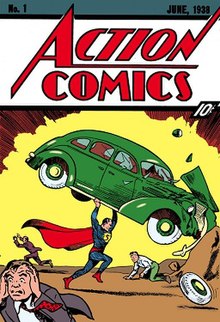
The duo's revised version of Superman appeared in the first issue of Action Comics, which was published on April 18, 1938. The issue was a huge success thanks to Superman's feature.[1][51][52]
Influences[edit]
Siegel and Shuster read pulp science-fiction and adventure magazines, and many stories featured characters with fantastical abilities such as telepathy, clairvoyance, and superhuman strength. One character in particular was John Carter of Mars from the novels by Edgar Rice Burroughs. John Carter is a human who is transported to Mars, where the lower gravity makes him stronger than the natives and allows him to leap great distances.[53][54] Another influence was Philip Wylie's 1930 novel Gladiator, featuring a protagonist named Hugo Danner who had similar powers.[55][56]
Superman's stance and devil-may-care attitude were influenced by the characters of Douglas Fairbanks, who starred in adventure films such as The Mark of Zorro and Robin Hood.[57] The name of Superman's home city, Metropolis, was taken from the 1927 film of the same name.[58] Popeye cartoons were also an influence.[58]
Clark Kent's harmless facade and dual identity were inspired by the protagonists of such movies as Don Diego de la Vega in The Mark of Zorro and Sir Percy Blakeney in The Scarlet Pimpernel. Siegel thought this would make for interesting dramatic contrast and good humor.[59][60] Another inspiration was slapstick comedian Harold Lloyd. The archetypal Lloyd character was a mild-mannered man who finds himself abused by bullies but later in the story snaps and fights back furiously.[61]
Kent is a journalist because Siegel often imagined himself becoming one after leaving school. The love triangle between Lois Lane, Clark, and Superman was inspired by Siegel's own awkwardness with girls.[62]
The pair collected comic strips in their youth, with a favorite being Winsor McCay's fantastical Little Nemo.[58] Shuster remarked on the artists who played an important part in the development of his own style: "Alex Raymond and Burne Hogarth were my idols – also Milt Caniff, Hal Foster, and Roy Crane."[58] Shuster taught himself to draw by tracing over the art in the strips and magazines they collected.[3]
As a boy, Shuster was interested in fitness culture[63] and a fan of strongmen such as Siegmund Breitbart and Joseph Greenstein. He collected fitness magazines and manuals and used their photographs as visual references for his art.[3]
The visual design of Superman came from multiple influences. The tight-fitting suit and shorts were inspired by the costumes of wrestlers, boxers, and strongmen. In early concept art, Shuster gave Superman laced sandals like those of strongmen and classical heroes, but these were eventually changed to red boots.[34] The costumes of Douglas Fairbanks were also an influence.[64] The emblem on his chest was inspired by heraldic crests.[65] Many pulp action heroes such as swashbucklers wore capes. Superman's face was based on Johnny Weissmuller with touches derived from the comic-strip character Dick Tracy and from the work of cartoonist Roy Crane.[66]
The word "superman" was commonly used in the 1920s and 1930s to describe men of great ability, most often athletes and politicians.[67] It occasionally appeared in pulp fiction stories as well, such as "The Superman of Dr. Jukes".[68] It is unclear whether Siegel and Shuster were influenced by Friedrich Nietzsche's concept of the Übermensch; they never acknowledged as much.[69]
Comics[edit]
Comic books[edit]
Since 1938, Superman stories have been regularly published in periodical comic books published by DC Comics. The first and oldest of these is Action Comics, which began in April 1938.[1] Action Comics was initially an anthology magazine, but it eventually became dedicated to Superman stories. The second oldest periodical is Superman, which began in June 1939. Action Comics and Superman have been published without interruption (ignoring changes to the title and numbering scheme).[71][72] A number of other shorter-lived Superman periodicals have been published over the years.[73] Superman is part of the DC Universe, which is a shared setting of superhero characters owned by DC Comics, and consequently he frequently appears in stories alongside the likes of Batman, Wonder Woman, and others.
Superman has sold more comic books over his publication history than any other American superhero character.[74] Exact sales figures for the early decades of Superman comic books are hard to find because, like most publishers at the time, DC Comics concealed this data from its competitors and thereby the general public as well, but given the general market trends at the time, sales of Action Comics and Superman probably peaked in the mid-1940s and thereafter steadily declined.[75] Sales data first became public in 1960, and showed that Superman was the best-selling comic book character of the 1960s and 1970s.[2][76][77] Sales rose again starting in 1987. Superman #75 (Nov 1992) sold over 23 million copies,[78] making it the best-selling issue of a comic book of all time, thanks to a media sensation over the supposedly permanent death of the character in that issue.[79] Sales declined from that point on. In March 2018, Action Comics sold just 51,534 copies, although such low figures are normal for superhero comic books in general (for comparison, Amazing Spider-Man #797 sold only 128,189 copies).[80] The comic books are today considered a niche aspect of the Superman franchise due to low readership,[81] though they remain influential as creative engines for the movies and television shows. Comic book stories can be produced quickly and cheaply, and are thus an ideal medium for experimentation.[82]
Whereas comic books in the 1950s were read by children, since the 1990s the average reader has been an adult.[83] A major reason for this shift was DC Comics' decision in the 1970s to sell its comic books to specialty stores instead of traditional magazine retailers (supermarkets, newsstands, etc.) — a model called "direct distribution". This made comic books less accessible to children.[84]
Newspaper strips[edit]
Beginning in January 1939, a Superman daily comic strip appeared in newspapers, syndicated through the McClure Syndicate. A color Sunday version was added that November. Jerry Siegel wrote most of the strips until he was conscripted in 1943. The Sunday strips had a narrative continuity separate from the daily strips, possibly because Siegel had to delegate the Sunday strips to ghostwriters.[85] By 1941, the newspaper strips had an estimated readership of 20 million.[86] Joe Shuster drew the early strips, then passed the job to Wayne Boring.[87] From 1949 to 1956, the newspaper strips were drawn by Win Mortimer.[88] The strip ended in May 1966, but was revived from 1977 to 1983 to coincide with a series of movies released by Warner Bros.[89]
Editors[edit]
Initially, Siegel was allowed to write Superman more or less as he saw fit because nobody had anticipated the success and rapid expansion of the franchise.[90][91] But soon Siegel and Shuster's work was put under careful oversight for fear of trouble with censors.[92] Siegel was forced to tone down the violence and social crusading that characterized his early stories.[93] Editor Whitney Ellsworth, hired in 1940, dictated that Superman not kill.[94] Sexuality was banned, and colorfully outlandish villains such as Ultra-Humanite and Toyman were thought to be less nightmarish for young readers.[95]
Mort Weisinger was the editor on Superman comics from 1941 to 1970, his tenure briefly interrupted by military service. Siegel and his fellow writers had developed the character with little thought of building a coherent mythology, but as the number of Superman titles and the pool of writers grew, Weisinger demanded a more disciplined approach.[96] Weisinger assigned story ideas, and the logic of Superman's powers, his origin, the locales, and his relationships with his growing cast of supporting characters were carefully planned. Elements such as Bizarro, his cousin Supergirl, the Phantom Zone, the Fortress of Solitude, alternate varieties of kryptonite, robot doppelgangers, and Krypto were introduced during this era. The complicated universe built under Weisinger was beguiling to devoted readers but alienating to casuals.[97] Weisinger favored lighthearted stories over serious drama, and avoided sensitive subjects such as the Vietnam War and the American civil rights movement because he feared his right-wing views would alienate his left-leaning writers and readers.[98] Weisinger also introduced letters columns in 1958 to encourage feedback and build intimacy with readers.[99]
Weisinger retired in 1970 and Julius Schwartz took over. By his own admission, Weisinger had grown out of touch with newer readers.[100] Starting with The Sandman Saga, Schwartz updated Superman by making Clark Kent a television anchor, and he retired overused plot elements such as kryptonite and robot doppelgangers.[101] Schwartz also scaled Superman's powers down to a level closer to Siegel's original. These changes would eventually be reversed by later writers. Schwartz allowed stories with serious drama such as "For the Man Who Has Everything" (Superman Annual #11), in which the villain Mongul torments Superman with an illusion of happy family life on a living Krypton.
Schwartz retired from DC Comics in 1986 and was succeeded by Mike Carlin as an editor on Superman comics. His retirement coincided with DC Comics' decision to reboot the DC Universe with the companywide-crossover storyline "Crisis on Infinite Earths". In The Man of Steel writer John Byrne rewrote the Superman mythos, again reducing Superman's powers, which writers had slowly re-strengthened, and revised many supporting characters, such as making Lex Luthor a billionaire industrialist rather than a mad scientist, and making Supergirl an artificial shapeshifting organism because DC wanted Superman to be the sole surviving Kryptonian.
Carlin was promoted to Executive Editor for the DC Universe books in 1996, a position he held until 2002. K.C. Carlson took his place as editor of the Superman comics.
Aesthetic style[edit]
In the earlier decades of Superman comics, artists were expected to conform to a certain "house style".[102] Joe Shuster defined the
Batman #3
Batman theme by Big Nes
Download: Batman_3.p3t
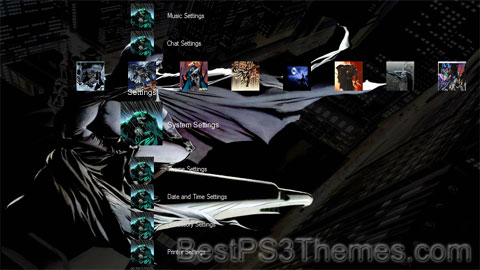
(12 backgrounds)
It has been suggested that Batman (Jace Fox) be merged into this article. (Discuss) Proposed since June 2024. |
| Batman | |
|---|---|
 | |
| Publication information | |
| Publisher | DC Comics |
| First appearance | Detective Comics #27 (cover-dated May 1939; published March 30, 1939)[1] |
| Created by | |
| In-story information | |
| Alter ego | Bruce Wayne |
| Place of origin | Gotham City |
| Team affiliations | |
| Partnerships |
|
| Notable aliases |
|
| Abilities |
|
Batman[a] is a superhero appearing in American comic books published by DC Comics. The character was created by artist Bob Kane and writer Bill Finger, and debuted in the 27th issue of the comic book Detective Comics on March 30, 1939. In the DC Universe continuity, Batman is the alias of Bruce Wayne, a wealthy American playboy, philanthropist, and industrialist who resides in Gotham City. Batman's origin story features him swearing vengeance against criminals after witnessing the murder of his parents Thomas and Martha as a child, a vendetta tempered with the ideal of justice. He trains himself physically and intellectually, crafts a bat-inspired persona, and monitors the Gotham streets at night. Kane, Finger, and other creators accompanied Batman with supporting characters, including his sidekicks Robin and Batgirl; allies Alfred Pennyworth, James Gordon, and love interest Catwoman; and foes such as the Penguin, the Riddler, Two-Face, and his archenemy, the Joker.
DC has featured Batman in many comic books, including comics published under its imprints such as Vertigo and Black Label. The longest-running Batman comic, Detective Comics, is the longest-running comic book in the United States. Batman is frequently depicted alongside other DC superheroes, such as Superman and Wonder Woman, as a member of organizations such as the Justice League and the Outsiders. In addition to Bruce Wayne, other characters have taken on the Batman persona on different occasions, such as Jean-Paul Valley / Azrael in the 1993–1994 "Knightfall" story arc; Dick Grayson, the first Robin, from 2009 to 2011; and Jace Fox, son of Wayne's ally Lucius, as of 2021.[4] DC has also published comics featuring alternate versions of Batman, including the incarnation seen in The Dark Knight Returns and its successors, the incarnation from the Flashpoint (2011) event, and numerous interpretations from Elseworlds stories.
One of the most iconic characters in popular culture, Batman has been listed among the greatest comic book superheroes and fictional characters ever created. He is one of the most commercially successful superheroes, and his likeness has been licensed and featured in various media and merchandise sold around the world; this includes toy lines such as Lego Batman and video games like the Batman: Arkham series. Batman has been adapted in live-action and animated incarnations, including the 1960s Batman television series played by Adam West and in film by Michael Keaton in Batman (1989), Batman Returns (1992), and The Flash (2023), Val Kilmer in Batman Forever (1995), George Clooney in Batman & Robin (1997), Christian Bale in The Dark Knight trilogy (2005–2012), Ben Affleck in the DC Extended Universe (2016–2023), and Robert Pattinson in The Batman (2022). Many actors, most prolifically Kevin Conroy, have provided the character's voice in animation and video games.
Publication history[edit]
Creation[edit]

In early 1939, the success of Superman in Action Comics prompted editors at National Comics Publications (the future DC Comics) to request more superheroes for its titles. In response, Bob Kane created "the Bat-Man".[6] Collaborator Bill Finger recalled that "Kane had an idea for a character called 'Batman,' and he'd like me to see the drawings. I went over to Kane's, and he had drawn a character who looked very much like Superman with kind of ...reddish tights, I believe, with boots ...no gloves, no gauntlets ...with a small domino mask, swinging on a rope. He had two stiff wings that were sticking out, looking like bat wings. And under it was a big sign ...BATMAN".[7] According to Kane, the bat-wing-like cape was inspired by his childhood recollection of Leonardo da Vinci's sketch of an ornithopter flying device.[8]
Finger suggested giving the character a cowl instead of a simple domino mask, a cape instead of wings, and gloves; he also recommended removing the red sections from the original costume.[9][10][11][12] Finger said he devised the name Bruce Wayne for the character's secret identity: "Bruce Wayne's first name came from Robert the Bruce, the Scottish patriot. Wayne, being a playboy, was a man of gentry. I searched for a name that would suggest colonialism. I tried Adams, Hancock ...then I thought of Mad Anthony Wayne."[13] He later said his suggestions were influenced by Lee Falk's popular The Phantom, a syndicated newspaper comic-strip character with which Kane was also familiar.[14]
Kane and Finger drew upon contemporary 1930s popular culture for inspiration regarding much of the Bat-Man's look, personality, methods, and weaponry. Details find predecessors in pulp fiction, comic strips, newspaper headlines, and autobiographical details referring to Kane himself.[15] As an aristocratic hero with a double identity, Batman has predecessors in the Scarlet Pimpernel (created by Baroness Emmuska Orczy, 1903) and Zorro (created by Johnston McCulley, 1919). Like them, Batman performs his heroic deeds in secret, averts suspicion by playing aloof in public, and marks his work with a signature symbol. Kane noted the influence of the films The Mark of Zorro (1920) and The Bat Whispers (1930) in the creation of the character's iconography. Finger, drawing inspiration from pulp heroes like Doc Savage, The Shadow, Dick Tracy, and Sherlock Holmes, made the character a master sleuth.[16][17]
In his 1989 autobiography, Kane detailed Finger's contributions to Batman's creation:
One day I called Bill and said, 'I have a new character called the Bat-Man and I've made some crude, elementary sketches I'd like you to look at.' He came over and I showed him the drawings. At the time, I only had a small domino mask, like the one Robin later wore, on Batman's face. Bill said, 'Why not make him look more like a bat and put a hood on him, and take the eyeballs out and just put slits for eyes to make him look more mysterious?' At this point, the Bat-Man wore a red union suit; the wings, trunks, and mask were black. I thought that red and black would be a good combination. Bill said that the costume was too bright: 'Color it dark grey to make it look more ominous.' The cape looked like two stiff bat wings attached to his arms. As Bill and I talked, we realized that these wings would get cumbersome when Bat-Man was in action and changed them into a cape, scalloped to look like bat wings when he was fighting or swinging down on a rope. Also, he didn't have any gloves on, and we added them so that he wouldn't leave fingerprints.[14]
Subsequent creation credit[edit]
Kane signed away ownership in the character in exchange for, among other compensation, a mandatory byline on all Batman comics. This byline did not originally say "Batman created by Bob Kane"; his name was simply written on the title page of each story. The name disappeared from the comic book in the mid-1960s, replaced by credits for each story's actual writer and artists. In the late 1970s, when Jerry Siegel and Joe Shuster began receiving a "created by" credit on the Superman titles, along with William Moulton Marston being given the byline for creating Wonder Woman, Batman stories began saying "Created by Bob Kane" in addition to the other credits.
Finger did not receive the same recognition. While he had received credit for other DC work since the 1940s, he began, in the 1960s, to receive limited acknowledgment for his Batman writing; in the letters page of Batman #169 (February 1965) for example, editor Julius Schwartz names him as the creator of the Riddler, one of Batman's recurring villains. However, Finger's contract left him only with his writing page rate and no byline. Kane wrote, "Bill was disheartened by the lack of major accomplishments in his career. He felt that he had not used his creative potential to its fullest and that success had passed him by."[13] At the time of Finger's death in 1974, DC had not officially credited Finger as Batman co-creator.
Jerry Robinson, who also worked with Finger and Kane on the strip at this time, has criticized Kane for failing to share the credit. He recalled Finger resenting his position, stating in a 2005 interview with The Comics Journal:
Bob made him more insecure, because while he slaved working on Batman, he wasn't sharing in any of the glory or the money that Bob began to make, which is why ...[he was] going to leave [Kane's employ]. ...[Kane] should have credited Bill as co-creator, because I know; I was there. ...That was one thing I would never forgive Bob for, was not to take care of Bill or recognize his vital role in the creation of Batman. As with Siegel and Shuster, it should have been the same, the same co-creator credit in the strip, writer, and artist.[18]
Although Kane initially rebutted Finger's claims at having created the character, writing in a 1965 open letter to fans that "it seemed to me that Bill Finger has given out the impression that he and not myself created the ''Batman, t' [sic] as well as Robin and all the other leading villains and characters. This statement is fraudulent and entirely untrue." Kane himself also commented on Finger's lack of credit. "The trouble with being a 'ghost' writer or artist is that you must remain rather anonymously without 'credit'. However, if one wants the 'credit', then one has to cease being a 'ghost' or follower and become a leader or innovator."[19]
In 1989, Kane revisited Finger's situation, recalling in an interview:
In those days it was like, one artist and he had his name over it [the comic strip] — the policy of DC in the comic books was, if you can't write it, obtain other writers, but their names would never appear on the comic book in the finished version. So Bill never asked me for it [the byline] and I never volunteered — I guess my ego at that time. And I felt badly, really, when he [Finger] died.[20]
In September 2015, DC Entertainment revealed that Finger would be receiving credit for his role in Batman's creation on the 2016 superhero film Batman v Superman: Dawn of Justice and the second season of Gotham after a deal was worked out between the Finger family and DC.[2] Finger received credit as a creator of Batman for the first time in a comic in October 2015 with Batman and Robin Eternal #3 and Batman: Arkham Knight Genesis #3. The updated acknowledgment for the character appeared as "Batman created by Bob Kane with Bill Finger".[3]
Golden Age[edit]
Early years[edit]
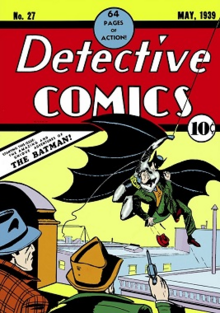
The first Batman story, "The Case of the Chemical Syndicate", was published in Detective Comics #27 (cover dated May 1939). It largely duplicated the plot of the story "Partners of Peril" in The Shadow #113, which was written by Theodore Tinsley and illustrated by Tom Lovell.[21] Finger said, "Batman was originally written in the style of the pulps",[22] and this influence was evident with Batman showing little remorse over killing or maiming criminals. Batman proved a hit character, and he received his own solo title in 1940 while continuing to star in Detective Comics. By that time, Detective Comics was the top-selling and most influential publisher in the industry; Batman and the company's other major hero, Superman, were the cornerstones of the company's success.[23] The two characters were featured side by side as the stars of World's Finest Comics, which was originally titled World's Best Comics when it debuted in fall 1940. Creators including Jerry Robinson and Dick Sprang also worked on the strips during this period.
Over the course of the first few Batman strips elements were added to the character and the artistic depiction of Batman evolved. Kane noted that within six issues he drew the character's jawline more pronounced, and lengthened the ears on the costume. "About a year later he was almost the full figure, my mature Batman", Kane said.[24] Batman's characteristic utility belt was introduced in Detective Comics #29 (July 1939), followed by the boomerang-like batarang and the first bat-themed vehicle, the Batplane, in #31 (September 1939). The character's origin was revealed in #33 (November 1939), unfolding in a two-page story that establishes the brooding persona of Batman, a character driven by the death of his parents. Written by Finger, it depicts a young Bruce Wayne witnessing his parents' murder at the hands of a mugger. Days later, at their grave, the child vows that "by the spirits of my parents [I will] avenge their deaths by spending the rest of my life warring on all criminals".[25][26][27]
The early, pulp-inflected portrayal of Batman started to soften in Detective Comics #38 (April 1940) with the introduction of Robin, Batman's junior counterpart.[28] Robin was introduced, based on Finger's suggestion, because Batman needed a "Watson" with whom Batman could talk.[29] Sales nearly doubled, despite Kane's preference for a solo Batman, and it sparked a proliferation of "kid sidekicks".[30] The first issue of the solo spin-off series Batman was notable not only for introducing two of his most persistent enemies, the Joker and Catwoman, but for a pre-Robin inventory story, originally meant for Detective Comics #38, in which Batman shoots some monstrous giants to death.[31][32] That story prompted editor Whitney Ellsworth to decree that the character could no longer kill or use a gun.[33]
By 1942, the writers and artists behind the Batman comics had established most of the basic elements of the Batman mythos.[34] In the years following World War II, DC Comics "adopted a postwar editorial direction that increasingly de-emphasized social commentary in favor of lighthearted juvenile fantasy". The impact of this editorial approach was evident in Batman comics of the postwar period; removed from the "bleak and menacing world" of the strips of the early 1940s, Batman was instead portrayed as a respectable citizen and paternal figure that inhabited a "bright and colorful" environment.[35]
Silver and Bronze Ages[edit]
1950s and early 1960s[edit]
Batman was one of the few superhero characters to be continuously published as interest in the genre waned during the 1950s. In the story "The Mightiest Team in the World" in Superman #76 (June 1952), Batman teams up with Superman for the first time and the pair discover each other's secret identity.[36] Following the success of this story, World's Finest Comics was revamped so it featured stories starring both heroes together, instead of the separate Batman and Superman features that had been running before.[37] The team-up of the characters was "a financial success in an era when those were few and far between";[38] this series of stories ran until the book's cancellation in 1986.
Batman comics were among those criticized when the comic book industry came under scrutiny with the publication of psychologist Fredric Wertham's book Seduction of the Innocent in 1954. Wertham's thesis was that children imitated crimes committed in comic books, and that these works corrupted the morals of the youth. Wertham criticized Batman comics for their supposed homosexual overtones and argued that Batman and Robin were portrayed as lovers.[39] Wertham's criticisms raised a public outcry during the 1950s, eventually leading to the establishment of the Comics Code Authority, a code that is no longer in use by the comic book industry. The tendency towards a "sunnier Batman" in the postwar years intensified after the introduction of the Comics Code.[40] Scholars have suggested that the characters of Batwoman (in 1956) and the pre-Barbara Gordon Bat-Girl (in 1961) were introduced in part to refute the allegation that Batman and Robin were gay, and the stories took on a campier, lighter feel.[41]
In the late 1950s, Batman stories gradually became more science fiction-oriented, an attempt at mimicking the success of other DC characters that had dabbled in the genre.[42] New characters such as Batwoman, the original Bat-Girl, Ace the Bat-Hound, and Bat-Mite were introduced. Batman's adventures often involved odd transformations or bizarre space aliens. In 1960, Batman debuted as a member of the Justice League of America in The Brave and the Bold #28 (February 1960), and went on to appear in several Justice League comic book series starting later that same year.
"New Look" Batman and camp[edit]
By 1964, sales of Batman titles had fallen drastically. Bob Kane noted that, as a result, DC was "planning to kill Batman off altogether".[43] In response to this, editor Julius Schwartz was assigned to the Batman titles. He presided over drastic changes, beginning with 1964's Detective Comics #327 (May 1964), which was cover-billed as the "New Look". Schwartz introduced changes designed to make Batman more contemporary, and to return him to more detective-oriented stories. He brought in artist Carmine Infantino to help overhaul the character. The Batmobile was redesigned, and Batman's costume was modified to incorporate a yellow ellipse behind the bat-insignia. The space aliens, time travel, and characters of the 1950s such as Batwoman, Ace the Bat-Hound, and Bat-Mite were retired. Bruce Wayne's butler Alfred was killed off (though his death was quickly reversed) while a new female relative for the Wayne family, Aunt Harriet Cooper, came to live with Bruce Wayne and Dick Grayson.[44]
The debut of the Batman television series in 1966 had a profound influence on the character. The success of the series increased sales throughout the comic book industry, and Batman reached a circulation of close to 900,000 copies.[45] Elements such as the character of Batgirl and the show's campy nature were introduced into the comics; the series also initiated the return of Alfred. Although both the comics and TV show were successful for a time, the camp approach eventually wore thin and the show was canceled in 1968. In the aftermath, the Batman comics themselves lost popularity once again. As Julius Schwartz noted, "When the television show was a success, I was asked to be campy, and of course when the show faded, so did the comic books."[46]
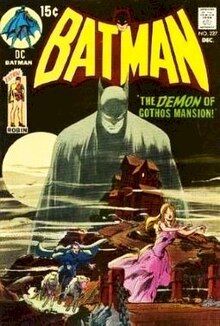
Starting in 1969, writer Dennis O'Neil and artist Neal Adams made a deliberate effort to distance Batman from the campy portrayal of the 1960s TV series and to return the character to his roots as a "grim avenger of the night".[47] O'Neil said his idea was "simply to take it back to where it started. I went to the DC library and read some of the early stories. I tried to get a sense of what Kane and Finger were after."[48]
O'Neil and Adams first collaborated on the story "The Secret of the Waiting Graves" in Detective Comics #395 (January 1970). Few stories were true collaborations between O'Neil, Adams, Schwartz, and inker Dick Giordano, and in actuality these men were mixed and matched with various other creators during the 1970s; nevertheless the influence of their work was "tremendous".[49] Giordano said: "We went back to a grimmer, darker Batman, and I think that's why these stories did so well ..."[50] While the work of O'Neil and Adams was popular with fans, the acclaim did little to improve declining sales; the same held true with a similarly acclaimed run by writer Steve Englehart and penciler Marshall Rogers in Detective Comics #471–476 (August 1977 – April 1978), which went on to influence the 1989 movie Batman and be adapted for Batman: The Animated Series, which debuted in 1992.[51] Regardless, circulation continued to drop through the 1970s and 1980s, hitting an all-time low in 1985.[52]
Modern Age[edit]
The Dark Knight Returns[edit]
Frank Miller's limited series The Dark Knight Returns (February–June 1986) returned the character to his darker roots, both in atmosphere and tone. The comic book, which tells the story of a 55-year-old Batman coming out of retirement in a possible future, reinvigorated interest in the character. The Dark Knight Returns was a financial success and has since become one of the medium's most noted touchstones.[53] The series also sparked a major resurgence in the character's popularity.[54]
That year Dennis O'Neil took over as editor of the Batman titles and set the template for the portrayal of Batman following DC's status quo-altering 12-issue miniseries Crisis on Infinite Earths. O'Neil operated under the assumption that he was hired to revamp the character and as a result tried to instill a different tone in the books than had gone before.[55] One outcome of this new approach was the "Year One" storyline in Batman #404–407 (February–May 1987), in which Frank Miller and artist David Mazzucchelli redefined the character's origins.[56] Writer Alan Moore and artist Brian Bolland continued this dark trend with 1988's 48-page one-shot issue Batman: The Killing Joke, in which the Joker, attempting to drive Commissioner Gordon insane, cripples Gordon's daughter Barbara, and then kidnaps and tortures the commissioner, physically and psychologically.[57]
The Batman comics garnered major attention in 1988 when DC Comics created a 900 number for readers to call to vote on whether Jason Todd, the second Robin, lived or died. Voters decided in favor of Jason's death by a narrow margin of 28 votes (see Batman: A Death in the Family).[56]
Knightfall[edit]
The 1993 "Knightfall" story arc introduced a new villain, Bane, who critically injures Batman after pushing him to the limits of his endurance. Jean-Paul Valley, known as Azrael, is called upon to wear the Batsuit during Bruce Wayne's convalescence. Writers Doug Moench,
Supernatural theme by R2_JOE Download: Supernatural.p3t Supernatural refers to phenomena or entities that are beyond the laws of nature.[1] The term is derived from Medieval Latin supernaturalis, from Latin super- (above, beyond, or outside of) + natura (nature).[1] Although the corollary term "nature" has had multiple meanings since the ancient world, the term "supernatural" emerged in the Middle Ages[2] and did not exist in the ancient world.[3]
The supernatural is featured in folklore and religious contexts,[4] but can also feature as an explanation in more secular contexts, as in the cases of superstitions or belief in the paranormal.[5] The term is attributed to non-physical entities, such as angels, demons, gods, and spirits. It also includes claimed abilities embodied in or provided by such beings, including magic, telekinesis, levitation, precognition, and extrasensory perception.
Occurring as both an adjective and a noun, antecedents of the modern English compound supernatural enter the language from two sources: via Middle French (supernaturel) and directly from the Middle French's term's ancestor, post-Classical Latin (supernaturalis). Post-classical Latin supernaturalis first occurs in the 6th century, composed of the Latin prefix super- and nātūrālis (see nature). The earliest known appearance of the word in the English language occurs in a Middle English translation of Catherine of Siena's Dialogue (orcherd of Syon, around 1425; Þei haue not þanne þe supernaturel lyȝt ne þe liȝt of kunnynge, bycause þei vndirstoden it not).[6]
The semantic value of the term has shifted over the history of its use. Originally the term referred exclusively to Christian understandings of the world. For example, as an adjective, the term can mean "belonging to a realm or system that transcends nature, as that of divine, magical, or ghostly beings; attributed to or thought to reveal some force beyond scientific understanding or the laws of nature; occult, paranormal" or "more than what is natural or ordinary; unnaturally or extraordinarily great; abnormal, extraordinary". Obsolete uses include "of, relating to, or dealing with metaphysics". As a noun, the term can mean "a supernatural being", with a particularly strong history of employment in relation to entities from the mythologies of the indigenous peoples of the Americas.[6]
The ancient world had no word that resembled "supernatural".[3] Dialogues from Neoplatonic philosophy in the third century AD contributed to the development of the concept the supernatural via Christian theology in later centuries.[7] The term nature had existed since antiquity, with Latin authors like Augustine using the word and its cognates at least 600 times in City of God. In the medieval period, "nature" had ten different meanings and "natural" had eleven different meanings.[2] Peter Lombard, a medieval scholastic in the 12th century, asked about causes that are beyond nature, in that how there could be causes that were God's alone. He used the term praeter naturam in his writings.[2] In the scholastic period, Thomas Aquinas classified miracles into three categories: "above nature", "beyond nature", and "against nature". In doing so, he sharpened the distinction between nature and miracles more than the early Church Fathers had done.[2] As a result, he had created a dichotomy of sorts of the natural and supernatural.[7] Though the phrase "supra naturam" was used since the 4th century AD, it was in the 1200s that Thomas Aquinas used the term "supernaturalis" and despite this, the term had to wait until the end of the medieval period before it became more popularly used.[2] The discussions on "nature" from the scholastic period were diverse and unsettled with some postulating that even miracles are natural and that natural magic was a natural part of the world.[2]
The metaphysical considerations of the existence of the supernatural can be difficult to approach as an exercise in philosophy or theology because any dependencies on its antithesis, the natural, will ultimately have to be inverted or rejected. One complicating factor is that there is disagreement about the definition of "natural" and the limits of naturalism. Concepts in the supernatural domain are closely related to concepts in religious spirituality and occultism or spiritualism.
For sometimes we use the word nature for that Author of nature whom the schoolmen, harshly enough, call natura naturans, as when it is said that nature hath made man partly corporeal and partly immaterial. Sometimes we mean by the nature of a thing the essence, or that which the schoolmen scruple not to call the quiddity of a thing, namely, the attribute or attributes on whose score it is what it is, whether the thing be corporeal or not, as when we attempt to define the nature of an angle, or of a triangle, or of a fluid body, as such. Sometimes we take nature for an internal principle of motion, as when we say that a stone let fall in the air is by nature carried towards the centre of the earth, and, on the contrary, that fire or flame does naturally move upwards toward firmament. Sometimes we understand by nature the established course of things, as when we say that nature makes the night succeed the day, nature hath made respiration necessary to the life of men. Sometimes we take nature for an aggregate of powers belonging to a body, especially a living one, as when physicians say that nature is strong or weak or spent, or that in such or such diseases nature left to herself will do the cure. Sometimes we take nature for the universe, or system of the corporeal works of God, as when it is said of a phoenix, or a chimera, that there is no such thing in nature, i.e. in the world. And sometimes too, and that most commonly, we would express by nature a semi-deity or other strange kind of being, such as t Chronicles of Narnia: Prince Caspian theme by Amras Download: CONPrinceCaspian.p3t Redirect to: ThunderCats theme by Landser Download: ThunderCats_2.p3t
ThunderCats is a media franchise, featuring a fictional group of cat-like humanoid aliens. The characters were created by Tobin Wolf and featured in an animated television series named ThunderCats, running from 1985 to 1989, which was animated by Japanese studio Pacific Animation Corporation, and co-produced by Rankin/Bass Productions.[1]
Like its predecessor Masters of the Universe, the ThunderCats franchise simultaneously launched as a line of action figures produced by LJN and as a syndicated after-school weekday cartoon.[2]
The original ThunderCats show was animated in Japan while being produced, written and voice acted in the United States.[3]
The series was distributed by Rankin/Bass Productions' then parent company Telepictures, which would later merge with Lorimar Television in February 1986.[4] In January 1989, Lorimar-Telepictures was purchased by and folded into Warner Bros., whose television syndication arm would eventually assume distribution of the show; Warner Bros. has owned the rights to the series (and all Lorimar-Telepictures programming) from that point on.
There were also several comic book series produced. A ThunderCats comic book series based on the animated series was published by Marvel Comics through its Star Comics imprint in 1985, lasting for three years and twenty-four issues.[5] During this time, a new series was published by Marvel UK consisting of 129 issues and was also published for three years.[6]
Beginning in 2002, ThunderCats titles were published by Wildstorm Productions, an imprint of DC Comics (Warner Bros. corporate sibling), and included five non-canon miniseries and several one shots.[7]
In March 2012, Panini Comics began publishing a new series in the United Kingdom to tie-in with the television series of 2011, titled ThunderCats Magazine. The first issue featured a strip called Safe Haven which was written by Ferg Handley and drawn by Cosmo White. Each issue also included additional features, such as character profiles, puzzles, a reader art page and a poster.
In February 2024 Dynamite Entertainment announced plans to publish a new ThunderCats series written by Declan Shalvey and drawn by Drew Moss.[8] In April 2024, Dynamite announced a spinoff series focusing on Cheetara.[9]
A side-scrolling video game based on the series, ThunderCats: The Lost Eye of Thundera, was published in 1987.
The ThunderCats have been added to the CMON Zombicide franchise in 2022 in the fantasy universe. Three special boxes allow to play the Thundercats as well as some Mutants as heroes, while Mumm-ra appears as a necromancer and an Abomination.
Items of clothing featuring the ThunderCats logo were available in the mid 1980s, and DVD boxsets releases of the original series helped new clothing products enjoy a resurgence in the mid to end of the 2000s, as nostalgia for the former children's favorite grew.[citation needed]
A film adaptation of the series was announced in June 2007; Aurelio Jaro was to produce a CGI animated feature film of ThunderCats, based on a script written by Paul Sopocy. Jerry O'Flaherty, veteran video game art director, had signed on to direct. The film was being produced by Spring Creek Productions.[10]
It was set for release in the summer of 2010,[11] but the movie was never greenlit,[12] and, as of 2024, has yet to be produced. Concept art for the film has also been leaked online.[12] In 2011, test footage in CGI was leaked onto YouTube.[13] In 2017, during the promotion of Resident Evil: The Final Chapter, Milla Jovovich expressed interest to portray Cheetara.[14]
In March 2021, it was announced that Warner Bros. was once more actively developing a live-action ThunderCats film with Adam Wingard set to direct the film, with a screenplay by Wingard and Simon Barrett, and Roy Lee and Dan Lin serving as producers.[15]
A second television series of the same name premiered in 2011. It was initially planned to have a fifty-two episode-long first season, but it was shortened down to 26, and cancelled shortly after season one finished airing. It later had reruns on Adult Swim's Toonami block, alongside Sym-Bionic Titan.
A third ThunderCats cartoon, ThunderCats Roar, premiered on Cartoon Network in 2020. The show's developers are Victor Courtright and Marly Halpern-Graser. Courtright previously worked on Pickle and Peanut as a writer/storyboard artist and created the Cartoon Network Studios digital series Get 'Em Tommy!. Halpern-Graser previously worked as a writer for various DC Nation Shorts, and was co-creator of the show on Disney XD, Right Now Kapow.
ThunderCats Roar features an explicitly cartoonish art style with a more lighthearted, comedic tone than previous ThunderCats installments. The show's premise is similar to the original; the ThunderCats escape their dying homeworld Thundera, only to crash land on Third Earth, facing off against various villains and their evil overlord, Mumm-Ra.[16]
However, after airing for only one season, it received negative reception from viewers, and the show was cancelled.
Supernatural
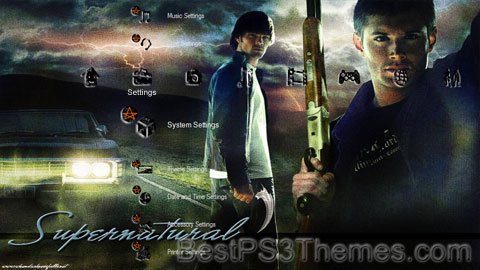
(13 backgrounds)

Part of a series on Anthropology of religion 
Social and cultural anthropology Part of a series on the Paranormal
Etymology and history of the concept[edit]
History of the concept[edit]
Epistemology and metaphysics[edit]
Alien Vs Predator #2
Chronicles of Narnia: Prince Caspian
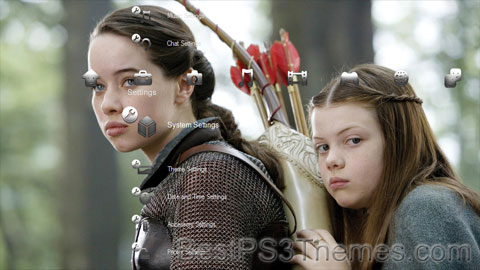
(16 backgrounds)
ThunderCats #2

(1 background)
ThunderCats Created by Tobin Wolf Original work ThunderCats (1985–89) Owner Warner Bros. (1989–present) Print publications Comics ThunderCats Films and television Animated series Games Video game(s) History[edit]
Notable characters[edit]
Later adaptations[edit]
Comics[edit]
Video game[edit]
Board game[edit]
Other merchandise[edit]
Film[edit]
Television series[edit]
Series Season Episodes Originally released First released Last released Network ThunderCats 1 65 September 9, 1985 December 20, 1985 Syndication 2 25 September 8, 1986 October 10, 1986 3 20 September 7, 1987 October 2, 1987 4 20 September 5, 1988 September 29, 1988 ThunderCats 1 26 July 29, 2011 June 16, 2012 Cartoon Network ThunderCats Roar 1 52 February 22, 2020 December 5, 2020 Cartoon Network ThunderCats (2011 TV series)[edit]
ThunderCats Roar[edit]
References[edit]



